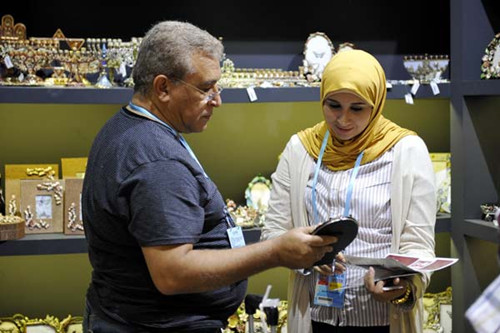
Buyers at the 113th China Import and Export Fair (Canton Fair) in Guangzhou in May. According to statistics from the fair, orders from the BRICS member nations of India, Brazil, Russia and South Africa increased by 5.2 percent year-on-year, while those from countries in the Middle East increased by 3.8 percent. LIANG XU/XINHUA
Ministry to help manufacturers target emerging markets, replace lost business
The Ministry of Commerce is planning to assist manufacturers to identify "specific regions" in key emerging export markets, particularly in India and other BRICS nations, to replace lost business in the eurozone and the United States.
Wang Shouwen, director-general of the department of foreign trade at the ministry, said on Thursday it planned to produce a list "that includes some key emerging markets and developing nations" which it will encourage exporters to tap.
The key factors to be taken into account in identifying the list of target markets will include the scale of the market, per capita GDP and national GDP, and foreign trade growth potential with China, said Wang.
He also said that the list will be drawn up based on the potential of specific areas to economically outperform developed nations this year.
According to the General Administration of Customs, China's 2012 exports to ASEAN countries grew by 20.1 percent, to Russia 13.2 percent, and to South Africa 14.7 percent, from 2011, while its total exports gained just 7.9 percent year-on-year last year.
In 2012, the Chinese mainland's trade with the European Union, US, Japan and Hong Kong accounted for 44 percent of total trade, down from 50.2 percent in 2007.
"We have seen progress in China's efforts to optimize its overseas markets," said Yao Jian, spokesman for the ministry.
Official statistics released at this year's Canton Fair — the biannual event seen as a barometer of China's foreign trade which closed on Sunday — showed orders from the BRICS member nations of India, Brazil, Russia and South Africa increased by 5.2 percent year-on-year, while those from countries in the Middle East increased by 3.8 percent.
Liu Jianjun, a spokesman for the fair and deputy director of the China Foreign Trade Center, urged Chinese exporters to diversify sales in emerging markets as demand from traditional buyers, especially those in Europe, remains weak.
Liu also said the outlook for Chinese exporters is still uncertain, as they face problems ranging from higher costs, a rising yuan, tightening credit and sluggish demand.
The European Commission's most recent predictions suggest that in 2013, the bloc's economy will shrink by 0.1 percent, and if the debt crisis does not deteriorate, the economy could begin to recover during the second half, with stable growth expected to take hold only in 2014.
Chinese industrial associations have also said that diversifying the country's export markets should be a priority.
Since the financial crisis of 2008, some member manufacturers have been expanding into emerging markets, said Li Wenfeng, vice-chairman of the China Chamber of Commerce for Import and Export of Light Industrial Products and Arts-Crafts.
"The opportunities in regions like Latin America, Africa, ASEAN and the Middle East are huge."
China has been the world's largest exporter of some light industries, including shoes, toys, watches, clocks, furniture, suitcases and ceramics, for many years.
In 2012, official figures showed the shipment of light industrial goods to ASEAN surged 42.7 percent, South Africa 29.6 percent, Brazil 21.7 percent, and to Russia 17.5 percent.
"Although shipments to European countries dropped sharply, emerging markets business made up for the losses," added Li.

Copyright ©1999-2011 Chinanews.com. All rights reserved.
Reproduction in whole or in part without permission is prohibited.